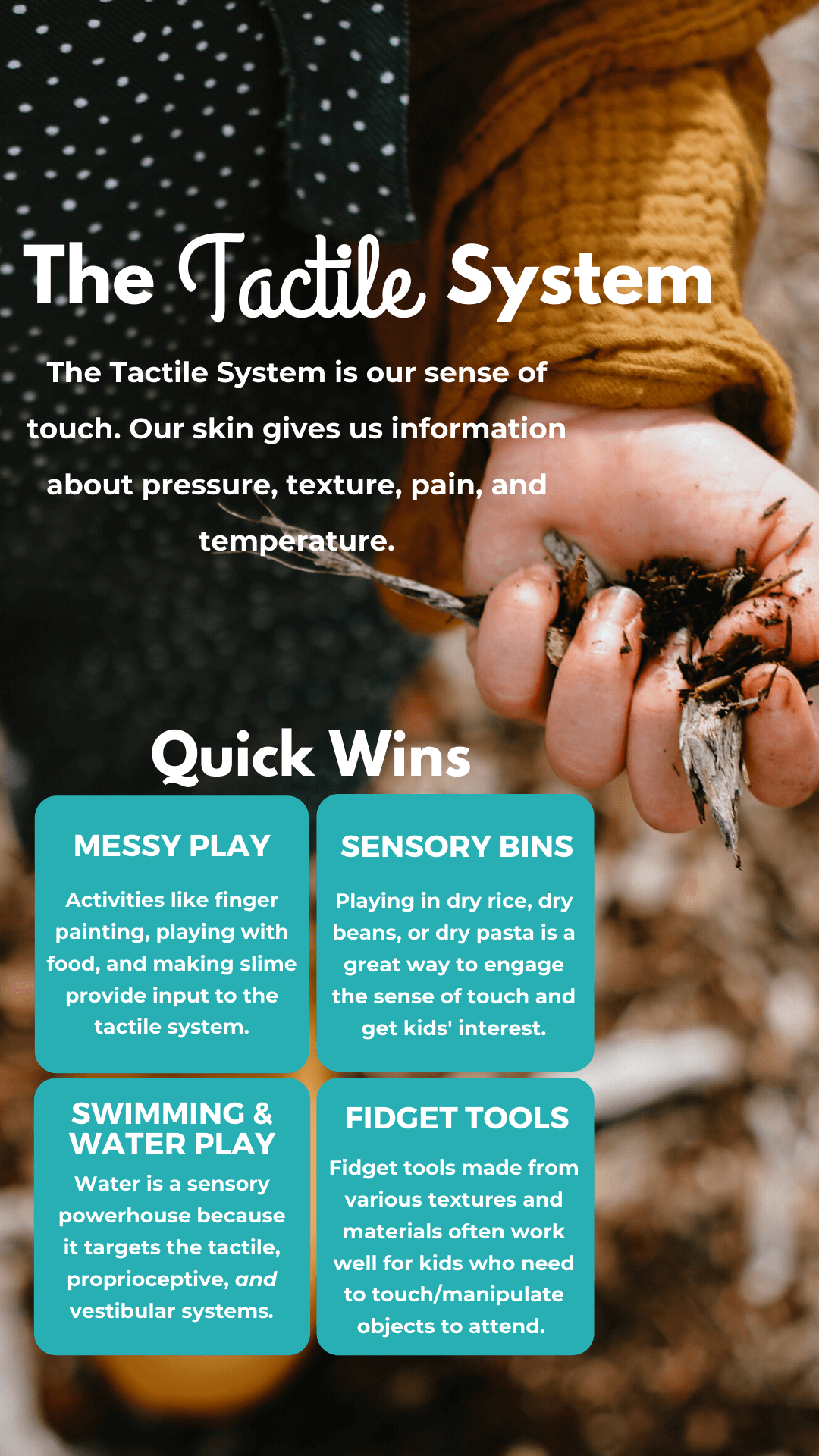What is the Tactile System?
The tactile sense is how we interpret the information we get from the receptors on our skin. When we encounter the feel of an object in our environment, our nervous system receives this information and helps us understand and differentiate pressure, texture, traction, and other tactile qualities of the object and lets us determine exactly what it is that we’re feeling. Our tactile system also helps us to understand temperature and to feel pain. There is a relationship between touch and the emotional centers in the brain, helping us make decisions and remember details about tactile experiences that we find pleasurable and ones that aren’t so pleasurable.
The sensory processing tactile system is what lets a child reach way down into his toy box and pull out his favorite action figure without even looking. It lets you know when the shower is warm enough (but not too hot) and helps you decide whether you prefer a calm bath or a strong shower. It’s how you know that you are touching something sharp, smooth, rough, or bumpy. But touch receptors aren’t only in your hands – in fact, they’re all over your body! It’s because of these receptors that you feel your foot hit the floor with every step or grab your favorite jeans or shirt because they feel good to wear.

RISE With Sensory Course
Are you ready to learn powerful sensory strategies to support kids’ sensory needs so they can RISE to their full potential?
Whether you’re a parent or a professional, this course is for you!
The RISE With Sensory Course is This class is AOTA approved for 7 hours (.7 CEU) and is the perfect starting point for new therapists, or refresher for experienced therapists.
Looking for a streamlined approach for working with kids with sensory concerns and for communicating clearly with parents and caregivers about sensory processing?
Click here to learn more!
A Healthy Tactile System
When the tactile sense is fully functioning, children are secure and organized enough in their bodies to be able to attend and respond to all of the other sensory information they encounter each day. They don’t become distracted by the constant tactile input they are experiencing in any given moment (the way their shirt feels on their arms, the feeling of the breeze hitting their face) because they are able to filter out which tactile information is important and which isn’t so important.
A child with a well-developed tactile sense engages in play easily with his peers and explores toys during parallel and group play. He effortlessly participates in activities of daily living involving touch including bathing, brushing teeth, washing hands, dressing and tolerating clothing, and mealtime routines. He shows curiosity by touching and interacting with his environment throughout his day in a controlled manner, not fearful of touching or being touched and also not preoccupied with touching everything around him.
Problems With Tactile Processing
Some children experience difficulty with processing the tactile information they encounter in everyday life. They may be overly sensitive (hypersensitive) to tactile input, causing them to withdraw from or avoid certain tactile experiences. To them, even the most simple touch experiences may be unpleasant or even painful.
Children who are hypersensitive to tactile input may avoid getting their hands or face messy, steering away from tactile sensory activities like fingerpainting, play dough, and even eating certain foods. This is known as tactile defensiveness. They may struggle with certain hygiene tasks, having extreme reactions or tantrums during toothbrushing, bathing, and haircuts. Tolerating certain types of clothing may be difficult.
Other children may have the opposite experience, seeking out more tactile input to give their bodies what they need. These children love to touch and be touched. They crave hugs, sit very closely to another person, and seek out different textures and touch experiences. They may “fiddle” with objects in their hands, rubbing them, turning them over and over, squeezing them. They may seem fearless, touching everything they see, even objects that might be dangerous.
Activities to Promote Tactile Processing
Here are some ideas that provide opportunities for play and exploration using the tactile sense. If you have a child that is over or under-reactive to touch, please be sure to contact your physician or an occupational therapist that can offer support for your child’s individual needs. These tactile sensory activities are meant only as fun ways to incorporate the tactile sense into every day play, not as treatment for children with sensory processing issues.
- Create sensory bins! Fill up a large tupperware container with sand, peas, rice, pasta, water etc. Once the child has explored a little, try hiding objects in the bin and see how many the child can find. Add a cup to practice scooping, dumping, pouring, and shaking. Have kids use their words to describe how the texture feels to them. Soft, bumpy, shiny, great, yucky, etc.
- Have a fashion show with your little one using clothing with varying textures (e.g. hat, shirt, pants, gloves, flip flops, boots, tights, etc.) Try making it into a game. How much clothing can the child get on to her body in 1 minute? Can she race against a friend or sibling?
- Go swimming! It’s the perfect activity for whole body tactile input! Any kind of water play makes for a great tactile experience: in the bath, in the sink, or just a big bowl of water on the floor! Add sponges, cups, a watering can, eye droppers, and medicine syringes for more fun and exploration!
- Play with sensory rich toys such as play dough, clay, and finger paint. Remember, you can play with more than just your hands! Get the feet in on the action too or let kids paint their whole bodies before bath time.
- Introduce toys with vibration such as a Squiggle Wiggle Writer, a vibrating pillow, or a vibrating stuffed animal.
- Make a touch and feel book with a different page for each texture. See if you can find something around the house or outside (swatch of scrap fabric, craft paper, sticks, leaves) to glue onto the pages of your book as examples of smooth, rough, soft, hard, bumpy, etc. Or check out some of our favorite touch and feel books: B is for Bear, Pat the Bunny, Eric Carle Touch-and-Feel Stroller Cards, Tails.
- Above all, let kids get dirty! We know this can be hard, but stay strong and remember that allowing your children to explore and get dirty, whether with an indoor cooking activity or playing outside in the mud (or in the rain!) helps develop a strong and healthy tactile system!
- Find all of our best tactile sensory activities here!
Learn More
Want to learn more about sensory processing? Check out our book, Sensory Processing 101!
Read up on the rest of the sensory systems by checking out our entire series about sensory processing, including the following posts:
Check out our series on Sensory Processing Strategies for Teens & Older Kids.
Be sure to click on over to Lemon Lime Adventures to read more about the tactile system from a mom and teacher’s point of view!
Check out our favorite toys for providing fun tactile play experiences for kids!

Latest posts by Claire Heffron (see all)
- Pro Tips for Conquering Toddler Separation Anxiety - April 25, 2024
- Cute Zipper Bags for Therapists - April 18, 2024
- Fairy Tale Games and Toys - April 12, 2024


[…] recent post about the Tactile System described how we use touch to receive and interpret information from our environment. This […]